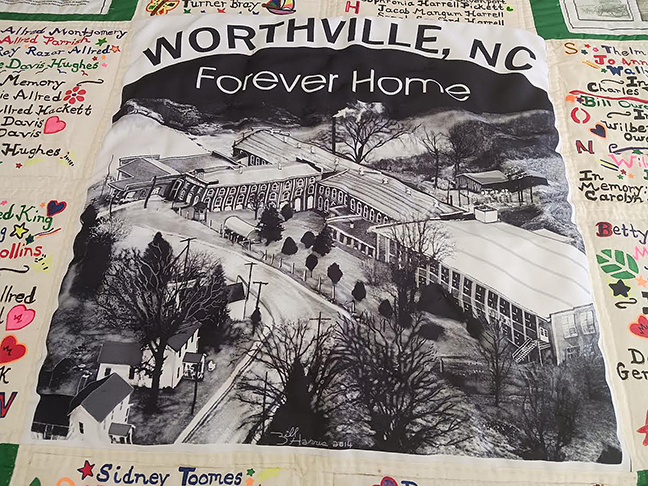Welcome!

The central focus of a Worthville historical quilt is the old mill. The backing of the quilt is fabric from the mill. Larry Penkava/Randolph Hub
After the fire
WORTHVILLE — “That is a beacon of our heritage destroyed.”
That statement by Wayne Bowman summed up the feelings of many after the old Worthville cotton mill was ravaged by fire on Jan. 20.
The building may be gone but memories of the old mill village have revived among those who lived there during its heyday.
Less than a week after the blaze set off an orange glow over the Worthville sky, six members of the Worthville Preservation Group met to recall many of those memories. Kathy Rollins, Betsy Moody, Jim Myers, Lynn Hudson, Carol Allred and Sally Groce gathered around mementoes of Worthville that have been collected by the preservation group.
Rollins said of the mill burning, “The mill is why we’re sitting here today. Families moved off the farm to work in the mill. We’re about the last generation” since the mill closed in 1976.
The cotton mill opened in 1881 as Worth Manufacturing. During the years, it changed hands and names to Riverside Cotton Mill, Leeward Cotton Mill, Fieldcrest Mills, and Baxter, Kelly & Foust.
After standing vacant for many years, the building was taken over by Prestige Fabricators for storage. There have been other businesses there but mostly for storage. It was never again used as a cotton mill. Rollins believes the building was up for sale when it burned.
Moody said her family moved out of the mill village when she was 10 years old. “My daddy was in charge of the village,” she said. “He kept it spotless.”
“I was born in a mill house near the mill in 1946,” Myers said. “It was like a wonderland with a large baseball field and two baseball teams. We had the river to play in. We were running around just having fun.”
Moody remembers there being “kids everywhere. We’d leave the house in the morning and stay gone all day. Whoever’s house we were at we ate lunch there. Everybody gathered at night and played hide-and-seek.”
Hudson recalled that “all the women in the village was your mom. If you did anything wrong, you knew for sure your parents would find out.”
A central feature of the village was the Worthville Store Co., which housed the mill store, the post office and the cafe.
While the children played during the summer months, many of the adults were working in the mill. It was hard work in a building with no air-conditioning.
Myers remembers watching as the mill workers came of a shift. “When a shift would change at the mill, the men would come out drained and worn out. They would come into the cafe for a small Coke and a BC powder and maybe a pack of peanuts. A lot of them had second jobs because they didn’t make a lot of money. If they lost their job, they lost their mill house, too. They worked extremely hard.”
Allred agreed about the hard work. “My daddy put me down there (in a mill job) during the summer between my freshman and sophomore years of college. It was to ‘let you see how hard it was’ so I'd stay in college.”
Rollins said her grandfather, Colon Allred, started working at the mill at the age of 9 and “worked ’til he retired, at least 65 years in the mill.” Other members of her family also worked at the mill.
“I’m so glad our parents and grandparents didn’t live to see the mill burn,” Rollins said. “I was sick on my stomach and in tears.”
Moody said she got a phone call and was told the mill was on fire. “It made me sick,” she said.
Hudson said John Milton Worth, who started the mill, also built the mill village. “He wanted it to be family-oriented,” she said.
Myers remembers being told that “there were a high number of (Worthville) men who went to World War II, in proportion to the population. Some didn’t come back. The mill also produced cloth for the war effort.”
Groce said her family moved to Worthville from Virginia. “When we came here, everybody knew everybody.” People who came to work at the mill often had nothing, but the company provided them with a house to live in and an account at the company store. “They paid it off when they got their paycheck.”
Allred noted that her family’s rent was $2 per room.
She said that during the war, Commonwealth Hosiery in Randleman was flooded and the river waters washed bags of hosiery down to Worthville. “People in Worthville had hose drying on their clotheslines.”
Winter provided new adventures for children in Worthville, according to Moody. “When it snowed, they built a big bonfire beside the road and we sledded down the road,” she said. “When a car came, everybody yelled, ‘Car!’ ”
During the summer, when the large ballfield was being used for baseball and softball, Worthville residents “took turns running concessions,” said Moody, adding that Buren Tysinger was the public address announcer. “People came from everywhere. It was a beautiful field.”
During the 1965 season, Moody said, the Worthville women’s softball team, which featured Kay Yow who later coached the NC State women’s basketball team, went to the softball World Series.
The Worthville Preservation Group, in addition to photographs, news clippings and other memorabilia, has a large quilt filled with squares celebrating the village’s history. The backing of the quilt comes from fabric produced by the Worthville mill.
